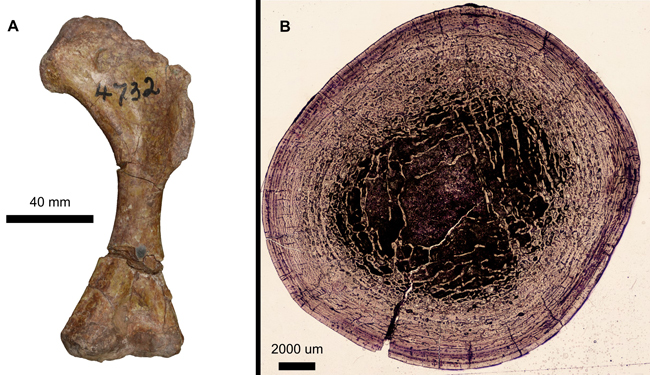An analysis of a single bone from the arm of a dinosaur suggests that South African sauropodomorphs were more diverse than previously suspected. In addition, the study published in Royal Society Open Science, proposes that the fossil bone represents a new taxon. As an adult, with a body weight of around seventy-five kilograms, this dinosaur is one of the smallest sauropodomorph taxa known to science and the smallest reported to date from Jurassic sediments.
Not a Juvenile Massospondylus carinatus
The fossil bone, a humerus, was found in 1978. It comes from a dinosaur bonebed (Massospondylus Assemblage Zone) associated with the Elliot Formation of South Africa. It had been thought to represent a juvenile Massospondylus (M. carinatus).

Picture credit: Everything Dinosaur
Studying the Sauropoda
Sauropodomorph dinosaurs are famously represented by colossal giants like Diplodocus, Patagotitan and Argentinosaurus, reaching body masses up to 70 tonnes. The ancestors of these animals, however, have more humble beginnings.
The first members of the group appear in the Triassic (Carnian period, 233–231 million years ago), with very small sizes (less than 15 kilograms, for example Buriolestes schultzi from Brazil).
As time progressed into the Jurassic (Hettangian period, 200 million years ago), early branching sauropodomorphs evolved a diverse range of body sizes, postures, and ecological adaptations. At this point, sauropodomorphs of less than 1 tonne are rare, although taxa like Massospondylus carinatus (adult body mass of around half a tonne) occur at nearly all dinosaur-bearing localities worldwide and can be locally superabundant.
The Smallest Sauropodomorph
The sauropodomorph fossil humerus BP/1/4732 from the Free State of South Africa was believed to be a juvenile Massospondylus carinatus specimen until now. A recent morphological and osteohistological study found that it was in fact an adult individual of a new species of dinosaur. The latter would have a fully grown body mass of approximately 75 kilograms, making it the smallest known adult sauropodomorph dinosaur from the Jurassic, and the first one weighing less than 100 kilograms.

Dr Kimberley Chapelle, commented:
“Until now, we were unaware that early sauropodomorphs could reach such small sizes during the Jurassic period, so the smallest skeletons were assumed to belong to juvenile individuals. We can now reassess these skeletons discovered in southern Africa and hopefully find a more complete individual from which we can name a new species.”
Not Possible to Erect a New Genus
With just a single bone it is not possible to erect a new genus. Previously, all sauropodomorph fossils found in that locality were ascribed to Massospondylus. However, more detailed assessments of the fossil material revealed that some of the bones represent different genera. As a PhD student, Kimberley Chapelle worked on a set of fossils that led to the establishment of a new South African sauropodomorph species named Ngwevu intloko.
To read Everything Dinosaur’s blog post about the discovery of Ngwevu intloko: New Dinosaur Species Hiding in Plain Sight.
Dr Chapelle added:
“Small ornithischian dinosaurs like Lesothosaurus first appeared in southern Africa during the Early Jurassic, and some scientists suggest they might have outcompeted early sauropodomorphs. I think this is unlikely, as many similarly sized mammals share similar niches today. Instead, it’s possible that sauropodomorphs lost the ability to stay this small as part of the evolution of large size, but we just don’t know.”
Everything Dinosaur acknowledges the assistance of a media release from the corresponding author in the compilation of this article.
The scientific paper: “Osteohistology reveals the smallest adult Jurassic sauropodomorph” by Kimberley E. J. Chapelle, Jennifer Botha and Jonah N. Choiniere published in Royal Society Open Science.






Leave A Comment